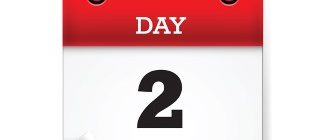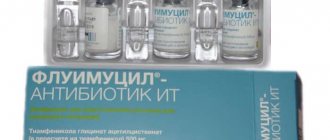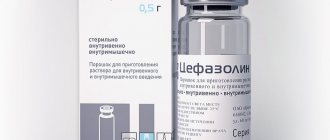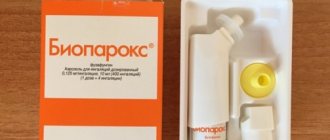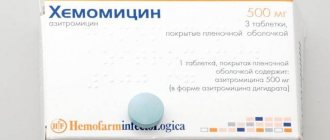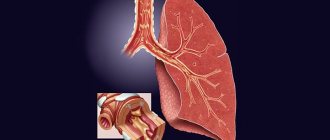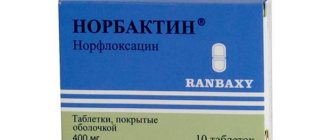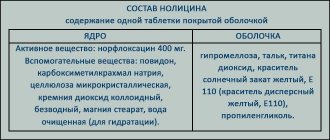Compound
The main active ingredient of the drug is norfloxacin .
The auxiliary components of Norbactin are as follows: MCC , sodium lauryl sulfate , colloidal silicon dioxide , purified talc , croscarmellose sodium , corn starch , magnesium stearate .
The shell contains the following substances: hypromellose , purified talc, purified water, macrogol 400, titanium dioxide.
Norbactin and its action
Norbactin tablets are an antibacterial agent from the group of fluoroquinolones. It contains the antimicrobial component norfloxacin in an amount of 400 mg. The drug is produced (India). Price for 10 tablets - 250 rubles. Auxiliary components of tablets:
- cellulose;
- starch;
- silicon dioxide;
- magnesium stearate;
- talc;
- croscarmellose sodium.
The drug helps destroy bacterial infection in the body. It has a bactericidal effect, inhibits the microbial enzyme DNA gyrase, without which bacterial cells cannot exist.
After destabilization of the DNA chains, microbial cells die.
The medicine finds its use if the infectious disease is caused by microbes sensitive to it. These include enterococci, staphylococci, streptococci, a number of gram-negative aerobes, Proteus, Neisseria, E. coli and many others. Only obligate anaerobes do not show sensitivity to the drug.
Pharmacodynamics and pharmacokinetics
Once in the body, the drug affects the bacterial enzyme DNA gyrase. It destabilizes the DNA chain, which leads to the death of bacteria. The bactericidal effect occurs quite quickly. The development of plasmid-mediated resistance is minimal.
The drug affects most aerobic gram-negative microorganisms, as well as some gram-positive ones. This is a potent antipseudomonal agent .
The medicine is well absorbed from the gastrointestinal tract. However, you should not take it with food as this will reduce its effectiveness. For better absorption, it should be consumed on an empty stomach.
The maximum concentration of the drug is 1-2 hours after administration. The degree of protein binding is 14%. Widely distributed in tissues, but does not penetrate bones and the central nervous system. Bioavailability is about 40%, half-life is 3.5-6.5 hours, but high concentrations are found in tissues for longer.
The drug is partially processed in the liver. Some amounts are excreted in bile, but mainly in urine and feces.
Pharmacological properties of the drug Norbactin
Pharmacodynamics . An antibacterial drug of the fluoroquinolone series with a wide spectrum of bactericidal action, the mechanism of which is based on the inhibition of DNA gyrase of the bacterial cell, as a result of which the function of the DNA bacterium is disrupted. Norbactin is active against a wide range of gram-positive and gram-negative microorganisms, including strains resistant to penicillins, cephalosporins, aminoglycosides, tetracyclines, and sulfonamides. The main part of the spectrum of action of norfloxacin, with possible geographical differences in sensitivity, is the effect on Neisseria gonorrhoeae (including penicillinase-producing strains). Norfloxacin is generally effective against pathogens that cause urinary tract infections, such as E. coli, Enterobacter spp., Klebsiellae, Proteus spp., Pseudomonas aeruginosa and Serratia marcescens . In addition, norfloxacin may be effective against enteritis-causing pathogens such as E. coli, Salmonella enteritis, and Campylobacter spp. Norfloxacin is moderately active against certain strains of Ureaplasma urealyticum . Resistance should be expected from Enterococcus faecalis and Enterococcus faecium. Norfloxacin is ineffective against obligate anaerobic pathogenic microorganisms such as Actinomyces spp., Bacterioides spp., Clostridium spp. (except for certain strains of C. perfringens ) and Peptostreptococcus spp. , as well as against Stenotrophomonas maltophilia and Chlamydia trachomatis . There is partial cross-resistance between norfloxacin and other fluoroquinolones. There is no cross-resistance with structurally unrelated drugs such as penicillins, cephalosporins, tetracyclines, macrolide antibiotics, aminoglycosides and sulfonamides, 2,4-dihydropyrimidines or combinations of these substances (co-trimoxazole). Methicillin-resistant staphylococci are mostly resistant to fluoroquinolones. Pharmacokinetics . Norfloxacin is rapidly absorbed from the gastrointestinal tract after oral administration, the absolute bioavailability of the drug is 30–40%. Eating slows down the absorption of the drug. The maximum concentration in blood plasma is achieved within 1–2 hours after oral administration at a dose of 400 mg. The half-life of the drug is about 4 hours, increases with renal failure and with increasing doses of the drug. About 14% of the drug binds to blood plasma proteins. Norfloxacin creates high concentrations in the tissues of the urogenital tract, in urine and bile. Approximately 30% of the dose is excreted unchanged in the urine over 24 hours. About 30% of the dose is excreted in the feces.
Indications for use of Norbactin
Norbaktin is used for cystitis , pyelonephritis , urethritis , as well as for bacterial infections of the gastrointestinal tract, genital organs and uncomplicated gonorrhea :
- prostatitis;
- endometritis;
- cervicitis;
- salmonellosis;
- shigellosis.
Indications for use of Norbactin also include its use by patients with granulocytopenia and travelers' diarrhea as a prophylactic agent.
Contraindications
Norbactin is contraindicated for the treatment of children under 18 years of age and patients with hypersensitivity to norfloxacin. Also, the drug should not be taken during pregnancy and lactation. Contraindications also include diseases such as:
- atherosclerosis of cerebral vessels;
- inflammatory processes in tendons;
- cerebrovascular accidents;
- severe renal failure.
Contraindications to the use of the drug
Norbactin is used with caution when:
- epilepsy;
- convulsions;
- lesions of the central nervous system;
- heart diseases;
- liver diseases.
Instructions for use of Norbactin
If the patient is prescribed Norbactin, the instructions for use provide for different dosages, which depend on what the tablets are used for. 400 mg of the drug 2 times a day is taken for:
- urinary tract infections - within 7-10 days;
- recurring or chronic urinary tract infections with exacerbations - for a month, and then, if necessary, use 400 mg per day for up to 12 weeks;
- chemoprophylaxis before and after urological operations;
- intestinal infections - within 5 days;
- acute uncomplicated cystitis - within 3 days.
400 mg once a day is prescribed if the indications for use of Norbactin are as follows:
- prevention of traveler's diarrhea ;
- renal failure.
For acute uncomplicated gonococcal infection, the instructions for use of Norbactin include taking 800 mg once.
Overdose of Norbactin, symptoms and treatment
Symptoms: increased body temperature up to febrile levels, shortness of breath, leukopenia, thrombocytopenia, acute hemolytic anemia, allergic reactions, gastrointestinal disorders, renal failure. Treatment: in case of acute overdose, calcium-containing solutions are taken orally to convert norfloxacin into a complex with calcium, which is absorbed in a very small amount into the gastrointestinal tract. The patient is carefully examined and, if necessary, symptomatic treatment is prescribed; ensure sufficient fluid intake, perform hemodialysis and peritoneal dialysis.
Overdose
In case of an overdose of the drug , dizziness , vomiting cold sweat , nausea , drowsiness , as well as a puffy facial expression without changes in the main hemodynamic parameters .
Treatment includes gastric lavage and adequate hydration therapy with forced diuresis . In addition, examination and hospitalization under the supervision of specialists for several days is necessary.
Directions for use and dosage
When prescribing Norbactin, the doctor, taking into account the dosage of the medicine, draws up a treatment regimen. The tablets are taken orally 1 hour before meals on an empty stomach, without chewing first; they should be swallowed whole with a small amount of water. The average course of treatment is 7-10 days. The daily dose depends on the diagnosis of the patient, his body characteristics and age.
The instructions describe some courses of treatment:
- 1For pyelonephritis and infections of the urinary system, 400 mg is prescribed 2 times a day. Treatment lasts 7 days.
- 2For uncomplicated cystitis, 200-400 mg is prescribed 2 times a day. Treatment 7 days.
- 3For gonococcal infection, 800 mg once.
- 4For infections of the gastrointestinal tract, 400 mg is prescribed 3 times a day, for a course of 5 days.
- 5For infection of the genital organs, 400-600 mg 2 times a day, for a course of 7 days.
- 6To prevent sepsis in neuropathy, a course of 400 mg 3 times a day is prescribed for 8 weeks.
- 7For the treatment of infectious diseases with liver and kidney failure, 200 mg 3 times a day.
Original instructions for Norbactin
The instructions indicate that in case of epilepsy, convulsive syndrome, as well as liver and kidney failure, doctors must individually adjust the daily dose of the drug; usually in such cases the dosage is halved.
The instructions also contain some recommendations for the use of the drug:
- 1When treating with Norbactin, it is necessary to control and maintain the body’s water balance.
- 2Take the tablets only on an empty stomach.
- 3When combined with drugs containing zinc, iron, magnesium, calcium or sucralfate, these drugs must be taken 2 or 2 hours after taking Norbactin.
- 4The drug affects the psychomotor reactions of the body, therefore it is not recommended to drive a vehicle while treating with Norbactin.
- 5If there is no positive dynamics on the 3rd day of treatment, you must consult a doctor and change the medicine.
- 6If pain in the joints and tendons occurs, you should immediately stop taking the drug and consult a doctor.
- 7To eliminate the possibility of photosensitivity during the period of therapy, it is necessary to limit visits to the solarium and outdoor tanning.
Interaction
The absorption of Norbactin is made difficult by the use of antacids that contain aluminum and magnesium, as well as preparations with iron, sucralfate and zinc. There should be a break of at least 4 hours between their use.
In addition, this drug reduces the clearance of theophylline and the effect of nitrofurans , and also increases the content of indirect anticoagulants and cyclosporine in the blood serum.
The drug should be taken with caution in combination with drugs that reduce the seizure threshold, otherwise it may cause epileptiform seizures .
The simultaneous use of Norbactin and drugs that lower blood pressure can cause a sharp decrease in blood pressure. So the heart rate and ECG readings must be carefully monitored.
Drug interactions Norbactin
Norfloxacin inhibits the CYP1A2 enzyme, which may lead to interaction with other drugs that are metabolized by this enzyme. Nitrofurantoin. Antagonism between norfloxacin and nitrofurantoin has been demonstrated in vitro, so their combined use is undesirable . Probenecid reduces the excretion of norfloxacin in the urine, but does not affect its concentration in the blood plasma. Theophylline . Increased levels of theophylline in blood plasma have been reported when combined with norfloxacin, as well as increased side effects of norfloxacin. With this combination of drugs, it is necessary to monitor the concentration of theophylline in the blood plasma and, if necessary, adjust the dose. Caffeine. Like other quinolones, norfloxacin inhibits the dehydration of caffeine, which may result in decreased excretion and increased plasma half-life of caffeine. This must be taken into account when drinking coffee, as well as when using medications that contain caffeine (analgesics). Cyclosporine . Increased plasma concentrations of cyclosporine have been reported when combined with norfloxacin. Therefore, the concentration of cyclosporine in the blood plasma should be monitored and the dose adjusted if necessary. Warfarin . Quinolones, including norfloxacin, can potentiate the effect of the oral anticoagulant warfarin or its derivatives (phenprocoumon, acenocoumarol), therefore, when used in combination, prothrombin time and other coagulation parameters are monitored. Hormonal contraceptives . The contraceptive effect of oral contraceptives in isolated cases may be weakened by treatment with antibiotics, therefore, when using norfloxacin and oral contraceptives in combination, it is additionally recommended to use non-hormonal contraceptive methods. Fenbufen . Based on animal studies, the combined use of quinolones with fenbufen may cause epileptic seizures, so this interaction should be avoided. Iron preparations, antacids and preparations containing magnesium, aluminum, calcium and zinc, calcium preparations, multivitamin preparations containing calcium should not be used in combination with Norbactin, since the absorption of norfloxacin may decrease, which leads to a decrease in its concentration in the blood plasma and urine . This also applies to oral nutritional solutions and most dairy products (milk or natural dairy products such as yogurt). Norbactin is taken 2 hours before or 4 hours after using these drugs or products.
Norbactin analogues
Level 4 ATX code matches:
Siflox
Hyleflox
Leflobakt
Lefoccin
Gatifloxacin
Ofloxacin
Faktiv
Tigeron
Lebel
Zanotsin
Lomefloxacin
Eleflox
Lomflox
Pefloxacin
Tsiprobay
Sparflo
Tariwid
Zoflox
Abaktal
Moxifloxacin
The following analogues of Norbactin can be obtained in pharmacies:
- Nolitsin;
- Norfloxacin;
- Normax.
Their prices may vary. Norfloxacin is considered the cheapest drug . The price of Norbactin, however, is also very affordable.
Reviews about Norbactin
Numerous reviews of Norbactin indicate that the medicine in most cases is truly effective. On the forums, many people ask whether this is an antibiotic or not, since taking such drugs is contraindicated for some. However, those who have already tried this drug note its speed.
Reviews of Norbactin report virtually no side effects. There is evidence of minor heartburn and other gastrointestinal problems, but the symptoms quickly disappear when the dosage is reduced. Reviews from doctors about this product are also mostly positive.
Side effects of the drug Norbactin
from the gastrointestinal tract: anorexia, bitterness in the mouth, nausea, vomiting, abdominal pain, diarrhea, pseudomembranous enterocolitis (with prolonged use), hepatitis, increased activity of liver transaminases, moderate gastralgia, heartburn, pancreatitis, jaundice; from the urinary system: crystalluria, glomerulonephritis, interstitial nephritis, dysuria, polyuria, albuminuria, urethral bleeding, hypercreatininemia; from the central nervous system: headache, dizziness, drowsiness, hallucinations, fatigue, mood changes, paresthesia, dissomnia, depression, anxiety, irritability, euphoria, disorientation, restlessness, polyneuropathy, including Guillain-Barré syndrome, epileptiform seizures; from the cardiovascular system: tachycardia, arrhythmia, decreased blood pressure, fainting, vasculitis; allergic reactions: skin itching, urticaria, swelling, exanthema, anaphylaxis, petechiae, hemorrhagic bullae and papules with crust formation as a manifestation of vascular involvement (vasculitis), angioedema; in isolated cases - exfoliative dermatitis, Stevens-Johnson syndrome, Lyell's syndrome, exudative polymorphic erythema, photosensitivity; from the musculoskeletal system: arthralgia, tendonitis, tendovaginitis, tendon ruptures, myalgia, arthritis; from the blood system: leukopenia, eosinophilia, decreased hematocrit, hemolytic anemia, thrombocytopenia; from laboratory parameters: neutropenia, increased levels of glutamate-oxaloacetate transaminase, glutamate-pyruvate transaminase and alkaline phosphatase in the blood plasma; others: vaginal candidiasis, dysopia, lacrimation, ringing in the ears. When using drugs based on norfloxacin, several cases of inflammation of the Achilles tendon were observed, which can lead to its rupture. Pseudomembranous colitis . Depending on the indications, the issue of discontinuing norfloxacin therapy is decided and appropriate treatment of the adverse reaction is immediately started (use of appropriate antibiotics/chemotherapeutic drugs, the effectiveness of which has been clinically proven). In this case, you should not use drugs that suppress peristalsis. Severe hypersensitivity reactions (anaphylaxis) . If such reactions occur, treatment with norfloxacin is immediately stopped and appropriate emergency measures are taken (administration of antihistamines, corticosteroids, sympathomimetics, and, if necessary, mechanical ventilation). Epileptiform seizures. Appropriate emergency measures are taken (restoration and maintenance of airway patency, administration of anticonvulsants - diazepam or barbiturates).
Norbactin price
The price of Norbactin is about 90 rubles. This is an inexpensive and accessible remedy, which, according to reviews, is quite effective.
- Online pharmacies in RussiaRussia
- Online pharmacies in KazakhstanKazakhstan
ZdravCity
- Norbactin tablets p.p.o.
400 mg 20 pcs. Sun Pharmaceutical Industries Ltd./Ranbaxy Laboratories Limited RUR 335 order - Norbactin tablets p.p.o. 400 mg 10 pcs. SUN Pharmaceutikal Industries Ltd.
RUB 196 order
Pharmacy Dialogue
- Norbactin (tab.p.pl/vol. 400 mg No. 20)Ranbaxy
RUB 339 order
- Norbactin (tab.p.pl/vol. 400 mg No. 10)Ranbaxy
206 rub. order
show more
